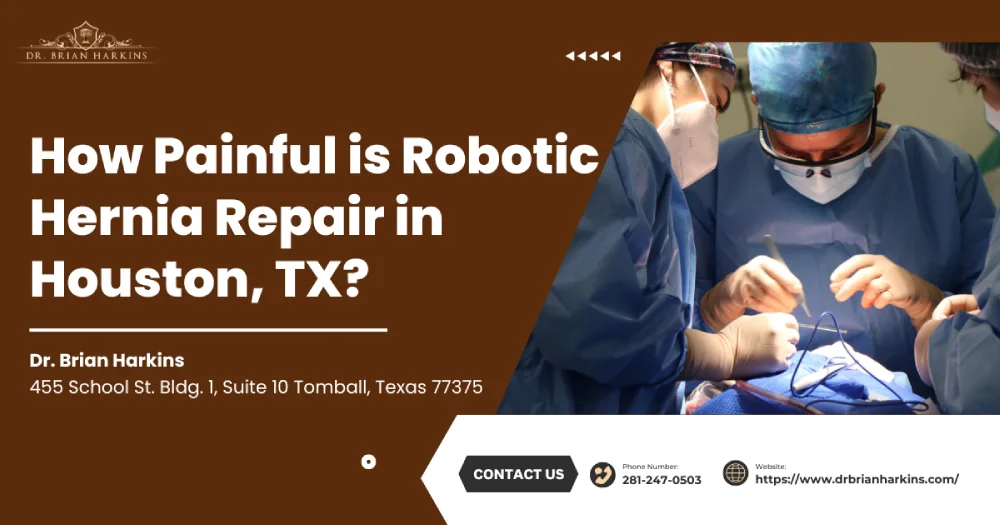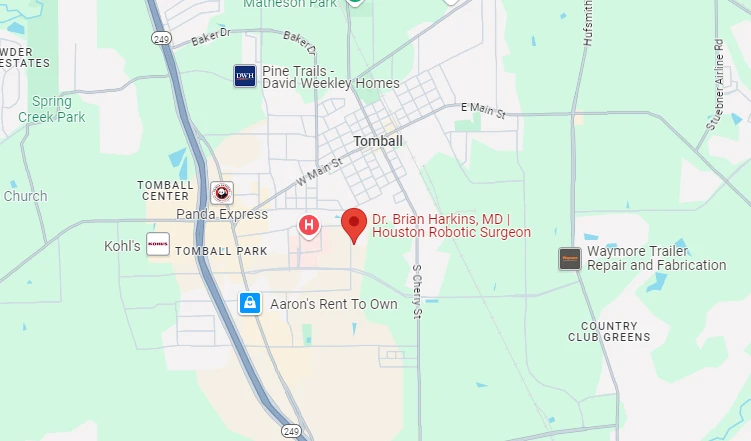
If you’re considering minimally invasive surgery and wondering how painful is robotic hernia repair in Houston, TX, the good news is that most patients report only mild to moderate discomfort. Robotic hernia repair is generally considered to be less painful than traditional open surgery because the minimally invasive approach relies on small incisions and the pinpoint accuracy of an advanced robotic system such as the da Vinci Surgical System. If you’re worried about postoperative pain, that single sentence should bring relief. In the next few minutes we’ll break down exactly how much discomfort to expect, why robotic technology matters, and what steps you—and your surgeon—can take before and after the day of surgery to ensure a smooth recovery.
Every type of hernia—inguinal, umbilical, ventral, or an abdominal hernia after C-section—creates a weak point in the abdominal wall. Repairing that defect requires surgical manipulation, which always causes some irritation. However, pain differs dramatically among traditional open, standard laparoscopic, and modern robotic hernia surgery. Knowing the differences prepares you for realistic expectations and a faster return to normal life.
During robotic surgery in Houston, surgeons operate through three to four pencil-eraser-sized ports rather than a 4-to-6-inch incision. Robotic arms that articulate like a human wrist allow the robotic surgeon to perform complex suturing from the inside, limiting traction on nerves and muscles. Less tugging equals less postoperative pain and a lower risk of hernia recurrence.
| Approach | Typical Incision Length | Average Pain Score (Day 1) | Hospital Stay | Back to Desk Work |
|---|---|---|---|---|
| Open Repair | 4–6 inches | 6–7 / 10 | 1–2 days | 2–3 weeks |
| Standard Laparoscopic | 3 ports, 0.5 in each | 4–5 / 10 | Same day | 1–2 weeks |
| Robotic Repair | 3–4 ports, 0.3 in each | 2–4 / 10 | Same day | 3–7 days |
Figures reflect average outcomes published by Houston robotic hernia centers and North Texas Surgical Specialists.
Having a clear timeline reduces stress—the single biggest magnifier of pain. Here’s how a typical minimally invasive hernia experience unfolds in a top Houston robotic hernia surgery program.
You’ll awaken under warm blankets with minimal grogginess because most Houston robotic programs use short-acting general anesthesia. Nurses will routinely ask your pain score and can provide IV Toradol or oral medication within minutes. Many patients report a sensation of tightness rather than sharp pain—yet another benefit of the minimally invasive approach.
A small inguinal hernia may only need a quarter-sized patch of mesh, whereas a giant abdominal wall defect could demand a larger prosthesis and more sutures, raising temporary discomfort.
Houston is home to fellowship-trained hernia surgeons who log 300+ robotic cases per year. Shorter operating times and advanced robotic techniques correlate strongly with lower pain, fewer complications, and reduced risk of hernia recurrence.
Chronic back pain, anxiety disorders, or prior opioid use can heighten perceived pain. On the other hand, patients who exercise regularly and maintain a healthy BMI often experience less pain and enjoy a significantly shorter recovery time.
Contact your hernia center if pain suddenly intensifies after day three, you run a fever over 100.4 °F, or the incision becomes red, warm, or drains pus. Early intervention lowers the risk of infection and speeds you back to normal activities.
Robotic hernia repair in Houston is designed for comfort: smaller incisions, precise stitching, and proven multimodal pain management translate into surprisingly mild soreness for most people. By choosing an experienced robotic surgeon, addressing lifestyle factors, and following smart at-home care, you can expect manageable discomfort that fades quickly—and a fast return to normal activities.
Robotic instruments pass through tiny ports rather than a large open wound, dramatically shrinking the surface area exposed to bacteria. Combined with shorter operative times and precise cauterization, this minimally invasive approach has been shown to reduce infection rates compared with traditional open hernia repair.
Absolutely. The enhanced visualization offered by the advanced robotic platform allows surgeons to dissect scar tissue from a prior operation without enlarging the incision. This precision helps lower the risk of yet another recurrence while keeping postoperative pain minimal.
Modern lightweight meshes are more flexible and produce a milder inflammatory response. Some are coated to reduce friction against internal organs. When secured robotically with fewer sutures, these meshes contribute significantly to less postoperative pain and faster recovery.
Yes, but patient selection matters. Surgeons may combine component-separation techniques with robotic instruments to close large gaps. Even when an open assist is required, the robotic portion minimizes overall tissue trauma and can shorten hospital stay.
General anesthesia is the standard because the abdomen is insufflated with carbon dioxide gas, which requires full muscle relaxation. The good news: modern short-acting agents wear off quickly, allowing most patients to walk and eat light meals just hours after surgery.
Light stationary biking is often approved by week two, while jogging may wait until week four. Always follow your surgeon’s timeline, as factors such as hernia size, mesh placement, and overall fitness influence your personal recovery time.
Persistent redness, warmth, swelling, purulent drainage, and fever above 101 °F beyond the first few days could indicate mesh infection. Early evaluation and antibiotics, sometimes combined with percutaneous drainage, can often salvage the repair without additional surgery.
While obesity can complicate any surgical procedure, robotic systems provide magnified 3D views that actually help in high-BMI patients. Surgeons may set a BMI threshold, but many perform safe repairs on patients with BMIs over 40 after pre-op optimization.
Hospital charges may be slightly higher due to the robotic equipment, but shorter stays, fewer complications, and quicker returns to work often offset the difference. Check with your insurance provider and surgeon’s billing team for an exact estimate.
Both are minimally invasive, but robotic instruments offer better articulation, making it easier to sew deep in the groin without extra incisions. Studies show patients experience less postoperative pain and potentially lower recurrence rates when bilateral repairs are performed robotically.


Dr. Brian Harkins is a renowned surgeon specializing in advanced, minimally invasive, and robotic surgical techniques. With a dedication to innovation and personalized patient care, he has transformed countless lives by delivering exceptional outcomes.

I want a website like this, where do i start?